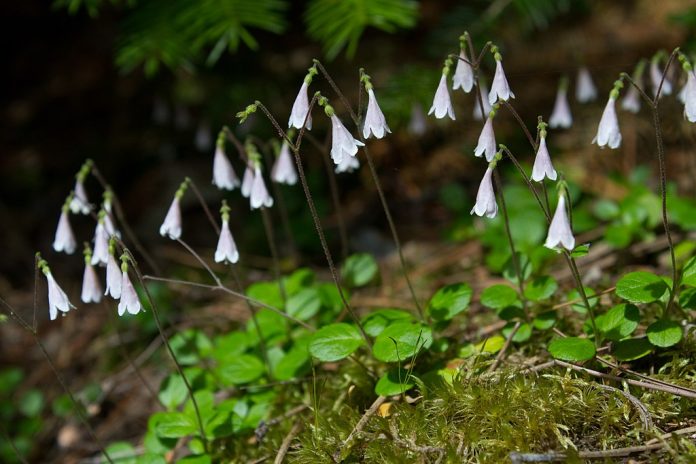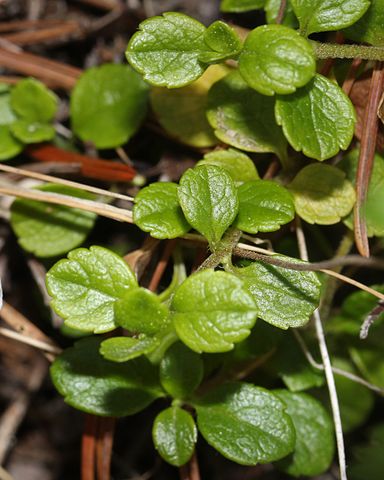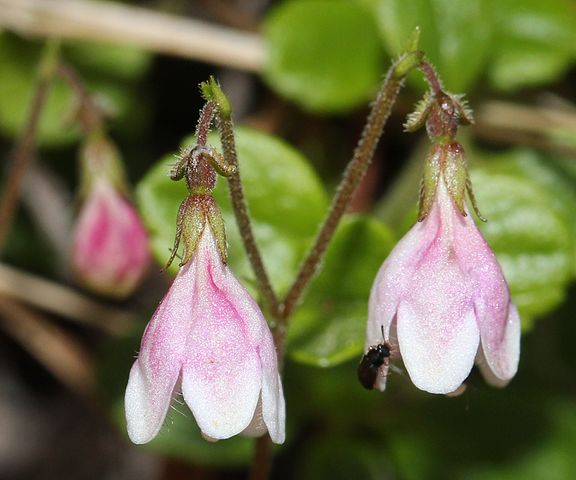
Featured Photo by Brian Gratwicke / CC BY-2.0
A field guide on how to identify and propagate Twinflower (Linnaea borealis), a hardy shrub that is native to the boreal forests.
How to Identify Twinflower (Linnaea borealis)
Leaves

Twinflower leaves have an obovate shape with a serrate margin, and they grow on the stems in opposite arrangements. Their leaves are thick and have a leathery texture.
The leaves are evergreen, which means they persist on the plant through winter.
You’ll notice twinflower shrubs like to grow on the ground in a spreading style, like a vine.
Flower

Twinflower blooms form in pairs, at the end of a branching stalk. Their flowers are relatively small, about half an inch each, they range from white to pink and hang downward from the stalk.
Flowering Season
Twinflower blooming season is from late spring to early summer.
Habitat
You’ll find twinflower shrubs growing in most of the boreal forest range, in mossy conifer or mixed forests.
Some other understory plants that associate with twinflower are:
- Eastern Teaberry (Gaultheria procumbens)
- Creeping Snowberry (Gaultheria hispidula)
- Bunchberry (Cornus canadensis)
- Bluebead (Clintonia borealis)
- Rock Harlequin (Corydalis sempervirens)
Wildlife Value
Twinflower does not seem to have a high wildlife value, as it does not produce fruits. The flowers do attract pollinators, and some insects may have symbiotic relationships with the plant.
It does have a very beautiful look and could be a great ground cover in an ornamental garden.
How to Propagate Twinflower (Linnaea borealis)

Hardiness Zone: 2-6

Soil Type: Clay, loam, sand.

Water: Normal

Exposure: Full Sun to Full Shade
You can propagate twinflower with two effective methods:
- Stem Cuttings: It provides established shrubs faster, and for this particular shrub, should be quite easy.
- By Seed: The success rate is high but takes longer to get established saplings.
Personally, I have never seen the seed stalk of this plant, I assume the seeds are very tiny.
The shrub grows in a vine-like manner, which means many parts of the stems will have roots attached to the soil. Because of this, it’s extremely easy to divide a mother shrub into many little cuttings.
How to Propagate Twinflower (Linnaea borealis) by Seed
The seeds always succeed the flower, which means technically around mid to late summer, you should be able to harvest seeds from the flower stalks.
How to Harvest Seeds
I assume they are very tiny and dispersed by wind, which means you should really keep an eye on the shrub to get the seed pod before it opens.
Sowing
Before sowing, twinflower (Linnea borealis) does benefit from a period of cold stratification.
Place your seeds in a ziplock bag with moistened moss, and place in the refrigerator for a minimum of 60 days.
After cold stratification has been completed, just remove them from the bag and place the moss in a closed terrarium with high moisture.
These will do well if moss-sown, since is how they generally germinate in nature.
Once the shrub is established, you may transplant into a rich soil.
How to Propagate Twinflower (Linnaea borealis) by Division
This here is the simplest way to propagate twinflower, since you can start immediately when you see the shrub.
The best time to divide twinflower is early in the morning with the dew, but pretty much any time in the summer.
Here’s how:
- First, identify a large mother plant.
- Next, look carefully at the stems to see where they’re going, and identify pieces that have roots in the ground.
- Then you may snip the pieces apart with clean secateurs, cutting each division at about 5-6 inches each, with at least one root clump.
One plant may give you up to 10 divisions, which is handy if you want to aggressively grow twinflower.
Keep them moist until ready to plant, here you have three options to get them started:
- Establish more roots in water: I have tried this and twinflowers really thrived here, but it’s only for a limited time.
- Establish more roots in moss: I think if you have a container that holds moisture well, twinflowers will love this. You just have to note that moss loses its moisture very fast, and ventilation is required to prevent mold.
- Establish more roots in soil: This will be the slower option but provide the most robust cuttings. I suggest a mix of peat moss, clay, and sand.
I would give them the rest of the summer to build their roots, let them overwinter, and plant them in their final location the next spring.
That’s it! Hopefully, that helps you propagate this beautiful little shrub, personally, it’s one of my favorites.
FAQ
A: Linnea borealis likes to grow in the cool, moist forest floors of the northern conifer and mixed forests. It grows all over the world in the North American and Eurasian boreal ecoregions.
A: Where I am from, Quebec, it’s quite common, although it may be rarer in other areas such as Scotland.
A: Yes, like many boreal forest shrubs, its leaves persist through winter, which means they are evergreen.
